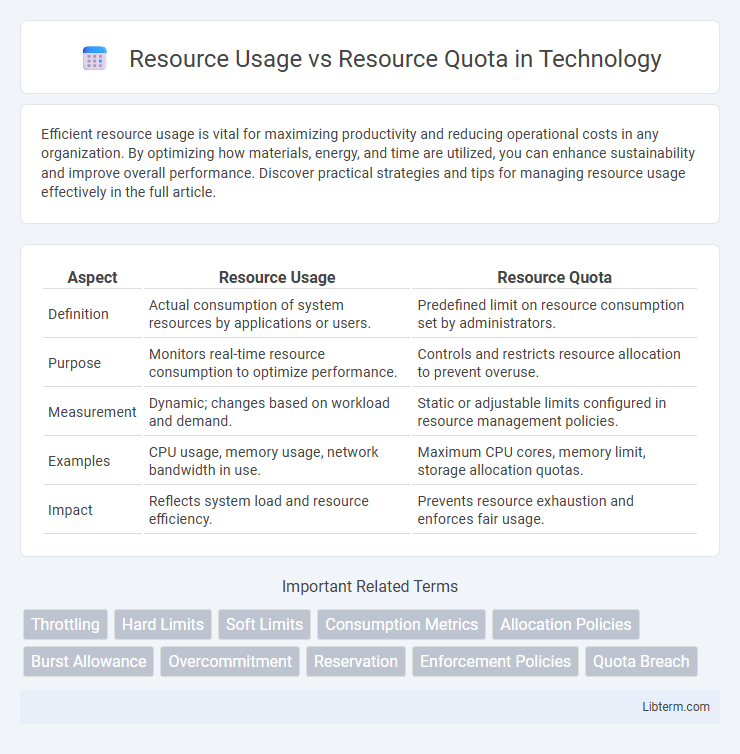Efficient resource usage is vital for maximizing productivity and reducing operational costs in any organization. By optimizing how materials, energy, and time are utilized, you can enhance sustainability and improve overall performance. Discover practical strategies and tips for managing resource usage effectively in the full article.
Table of Comparison
| Aspect | Resource Usage | Resource Quota |
|---|---|---|
| Definition | Actual consumption of system resources by applications or users. | Predefined limit on resource consumption set by administrators. |
| Purpose | Monitors real-time resource consumption to optimize performance. | Controls and restricts resource allocation to prevent overuse. |
| Measurement | Dynamic; changes based on workload and demand. | Static or adjustable limits configured in resource management policies. |
| Examples | CPU usage, memory usage, network bandwidth in use. | Maximum CPU cores, memory limit, storage allocation quotas. |
| Impact | Reflects system load and resource efficiency. | Prevents resource exhaustion and enforces fair usage. |
Understanding Resource Usage
Resource usage measures the actual consumption of CPU, memory, and storage by applications and containers within a cloud or container orchestration environment. Monitoring resource usage helps identify bottlenecks and optimize performance by providing real-time data on how much of the allocated resources are being utilized. Understanding resource usage is crucial for maintaining system stability and ensuring efficient distribution of resource quotas among workloads.
Defining Resource Quota
Resource Quota defines the maximum allowed consumption of compute resources such as CPU, memory, and storage within a Kubernetes namespace to prevent resource exhaustion and ensure fair allocation. It is implemented through Kubernetes API objects, specifying limits on resource types including pods, services, and persistent volume claims. Enforcing Resource Quotas helps maintain cluster stability by restricting resource usage and enabling efficient multi-tenant resource management.
Key Differences Between Usage and Quota
Resource usage measures the actual consumption of resources such as CPU, memory, and storage within a system, while resource quota sets a predefined limit on these resources to prevent overallocation. Usage tracks real-time metrics and current demand, providing insights into system performance and capacity utilization. Quota enforces constraints that ensure fair distribution and protect against resource exhaustion in multi-tenant or shared environments.
Importance of Monitoring Resource Usage
Monitoring resource usage is vital to prevent exceeding resource quotas, which can lead to service disruptions or degraded application performance. It ensures efficient allocation of CPU, memory, and storage, maintaining system stability and preventing bottlenecks. Continuous tracking enables proactive scaling and optimization, maximizing resource utilization while adhering to defined limits.
Setting Effective Resource Quotas
Setting effective resource quotas requires analyzing current resource usage metrics to prevent overallocation and ensure fair distribution across teams or applications. Resource quotas limit the consumption of CPU, memory, and storage, helping avoid performance degradation and system outages caused by resource contention. Monitoring usage trends allows administrators to adjust quotas dynamically, optimizing cluster stability and cost efficiency.
Common Issues with Resource Limits
Resource usage often exceeds resource quota due to improper configuration or underestimation of workload demands, leading to application throttling or failures. Common issues include memory leaks, CPU spikes, and unoptimized container resource requests that do not align with actual consumption patterns. Monitoring tools and proactive adjustment of quotas help prevent resource contention and ensure stable performance in containerized environments.
Strategies for Optimizing Resource Consumption
Resource usage should be continuously monitored against predefined resource quotas to prevent overallocation and ensure system stability. Implementing strategies such as autoscaling, resource limits, and priority-based scheduling optimizes resource consumption by dynamically adjusting workloads and allocating resources efficiently. Leveraging tools like Kubernetes Resource Quotas and Prometheus for real-time monitoring enhances the ability to predict and control consumption patterns, reducing waste and improving performance.
Tools for Tracking Usage and Quotas
Tools for tracking resource usage and quotas in cloud environments include Prometheus and Grafana, which provide real-time monitoring and visualization of resource consumption against set limits. Kubernetes metrics-server and Resource Metrics API enable detailed tracking of pod and node resource usage to ensure compliance with namespace quotas. Cloud provider dashboards like AWS CloudWatch and Google Cloud Monitoring offer integrated quota alerts and usage reports to prevent resource overconsumption.
Best Practices for Resource Management
Efficient resource management requires continuously monitoring Resource Usage against defined Resource Quotas to prevent overallocation and ensure system stability. Implementing granular quotas based on workload priority and historical consumption patterns helps maintain balanced resource distribution and avoids bottlenecks. Regular audits and dynamic adjustments of quotas aligned with changing operational demands optimize performance and minimize costs across cloud environments.
Future Trends in Resource Allocation
Future trends in resource allocation emphasize dynamic scaling and predictive analytics to optimize resource usage within predefined resource quotas. Advances in AI-driven resource management enable real-time adjustments to quotas based on workload patterns, improving efficiency and reducing waste. Cloud-native environments increasingly adopt automated quota enforcement and adaptive resource allocation to balance demand and capacity seamlessly.
Resource Usage Infographic

 libterm.com
libterm.com